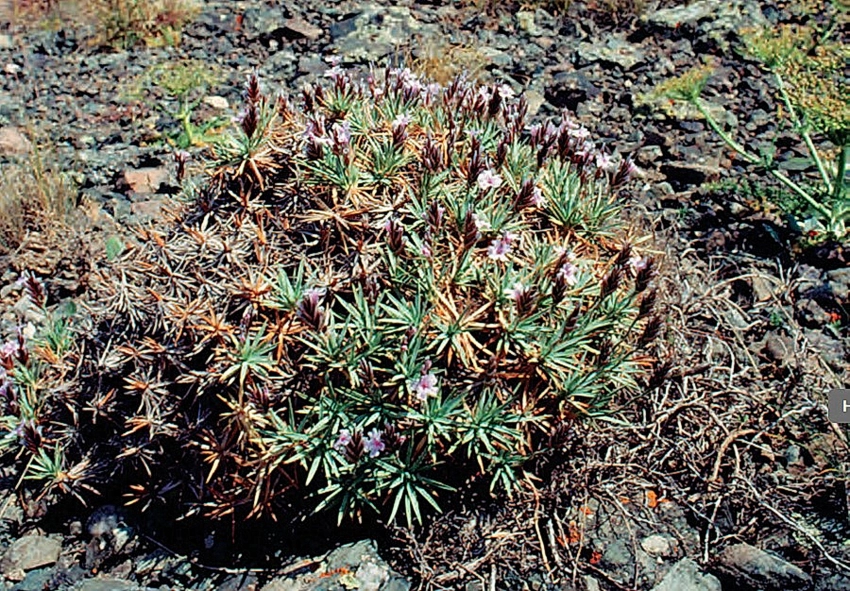RED BOOK: KGZ 26 Kabak-Too and Moldo-Too Key Biodiversity Area
Species that initiated the designation of KBA [and other globally threatened species that are present in the KBA but have not been confirmed to meet the global KBA criteria]: Acantholimon linczevskianum, Cousinia schischkinii, Mogoltavia narynensis, Nepeta narynensis, Seseli luteolum.

Akantolimon of Lynchevsky (Acantholimon linczevskianum)
Genus: Acantholimon - Plumbaginaceae - Plumbaginales - class: Dicotyledonous - division: Magnoliophyta.
Botanical description of the genus: Representatives of the genus are perennial evergreen subshrubs that form dense, hard, continuous cushions and carpets. The homeland of acantholimon is the steppe and mountainous regions of Armenia, Asia Minor, Tibet, the Mediterranean and the Caucasus. The genus Acantholimon consists of 295 species of evergreen plants.
Acantholimons are distinguished by their height, which can reach from 30 centimeters to 1 meter. The root system is well developed, of a mixed type, which allows it to grow well on rocky and gravelly substrates. Stems erect, branched, woody at the base. The leaves are intense dark green, rather long, hard, and needle-shaped. Elastic needle-like leaves are collected in rosettes. Fitting tightly to each other, they form neat prickly pillows.
Flowers in one-sided spike-shaped inflorescences. The corolla color ranges from pale pink to bright pink. Acantholimons bloom from July to August.
Interesting facts: Acantholimon is a genus of ground cover plants belonging to the family Plumbaginaceae. The name of the Greek etymology, “acanthos” – thorn and “leimon” - meadow, explains the life form of the plants.
Acantholimons are used in landscape design to create alpine slides and rocky gardens. In addition, the extract of these plants is used to treat wounds, burns and inflammatory processes on the skin. Acantholimones also have antibacterial properties and can be used as an antiseptic.
Sources of information: https://openfito.ru/vids/vid/21310
https://101dizain.ru/wiki/plant/alp/akantolimon.html
https://diymaven.ru/78320-akantolimon
Herbarium photo source: https://plant.depo.msu.ru/open/public/item/MW0594163

Cousinia of Schischkin (Cousinia schischkinii)
Genus: Cousinia - family: Compositae - order: Asteraceae - class: Dicotyledonous - division: Magnoliophyta.
Zoning Central Asia and Kazakhstan, Western Tien Shan and Karatau
Botanical description of the species: Two-year plan. The core root. The stem is 20-40 cm high, spreading branched and cobwebby from the base. The leaves are greenish on top, thinly and diffusely cobwebby, thinly grayish on the bottom; basal-short-stemmed, lanceolate, large-prickly along the edge; the lower stems are similar to basal ones. Baskets 30-36 mm wide. cobwebby, broadly pyramidal. Leaves of the wrapper are numerous, narrow-lanceolate, gradually prickly-pointed; outer - protruding, about 10-15 mm long; middle and inner - about 15 mm long, lanceolate, erect-protruding. The corollas are purple. Phenology. Blooms in June-July, bears fruit in July-August.
Ecology. It grows on stony-gravelly slopes and scree, at altitudes - 3000 of 2500-3000 m above sea level.
Distribution in Kyrgyzstan. Akshiyrak-Too, Kavak-Too, Kok-Irim-Too and Ferghana mountain ranges. General distribution. Endemic.
Cultivation. There is no information available.
Meaning. An ornamental plant. Security in Kyrgyzstan. No security measures were taken.
Source of information and photo: Lazkov G. A., Umralina A. R. Endemics and rare plant species of Kyrgyzstan (Atlas) - FAO. Ankara, 2015

Naryn’s mogoltavia (Mogoltavia narynensis)
Genus: Jurinēa- family: Compositae - order: Astroraceae - class: Dicotyledonous - division: Magnoliophyta.
Zoning: Central Asia and Kazakhstan, Northern and Central Tien Shan. Botanical description of the species. Semi-shrub forming turf. The caudex branches are covered with the remains of last year's shoots. Flowering stems 20-35 cm high, branching from the base, more or less pubescent, at the base with felt glomeruli in the leaf axils. The stem leaves are linear, 3-5 cm long, 2-3 mm wide, with the edges turned downwards, patchy on top, almost feltlike pubescent on the bottom. The baskets are solitary on long peduncles. The wrapper is ovate, 1.5-1.8 cm long; the leaves are lanceolate, keeled, herbaceous, pointed at the tip, spider-like pubescent. The flowers are lilac-white, far out of the basket. Phenology. Blooms in June, bears fruit in August. Ecology. It grows in rocky habitats among xerophilic shrubby vegetation, at an altitude of 800-1200 m above sea level.
Distribution in Kyrgyzstan. Chatkal and Ferghana ranges.
General distribution. Endemic. Cultivation. No information available. Meaning. A rare ornamental plant.
Security in Kyrgyzstan. No security measures were taken.
Source of information: Lazkov G. A., Umralina A. R. Endemics and rare plant species of Kyrgyzstan (Atlas) - FAO. Ankara, 2015
Photo source : https://www.plantarium.ru/page/view/item/61969.html

Naryn’s nepeta (Nepeta narynensis)
Genus: Nepeta - family: Lamiaceae - order: Lamiaceae - class: Dicotyledonous - division: Magnoliophyta.
Nepeta is a genus of perennial herbaceous plants with a pleasant aroma, belonging to the Lamiaceae family. It includes more than 200 plant species. They are united by the presence of an erect stem with small dark or gray-green leaves of triangular-rounded shape with jagged edges. On the tops of the shoots, the catnip forms dense paniculate or spike-shaped inflorescences of small fragrant flowers of white, purple, lilac or pink shades.
The herbaceous shrub is mostly found in the wild. Several species are represented in the culture. Most of them are naturally found in Europe, Asia and Africa. And only a few wild catnip plants grow in North America.
Information sources: https://openfito.ru/vids/vid/92789
https://leplants.ru/nepeta/
Photo source : https://www.plantarium.ru/page/view/item/61969.html
Yellowish Seseli (Seseli luteolum)
Genus: Seseli - family: Umbellaceae - order: Araliaceae - class: Dicotyledonous - division: Magnoliophyta.
Zoning Central Asia and Kazakhstan, Northern and Central Tien Shan
Botanical description of the genus: Genus of biennial or perennial plants of the Umbellaceae family, numbering about 50 species, The genus includes species distributed mainly in Asia Minor and Central Asia, Europe and Western Siberia. Typical places of growth are meadows, forests, steppes, rocky slopes and sands. Only a few species are used in culture. Popular names are suzik or crane grass.
Seseli is a herbaceous plant up to 100 cm tall with a single furrowed, sinuous or fusiform root, often used for medicinal purposes. The lower leaves are green with a bluish coating, vaginal, thrice-pinnately dissected, the lobes are linear pointed. The upper leaves are smaller, pinnate. The flowers are small, white or with a reddish tint, with multi-leaved linear-lanceolate wrappers, collected in umbrella inflorescences with numerous rays. The fruit is a two-seeded egg-shaped plant. The stallion blooms in July-August.
Botanical description of the species: Flowers: perianth actinomorphic; number of petals 5; inflorescence umbrella. Differences between shoots: leaf arrangement on the shoot is another one. Fruits: dry visloplodnik; dry type; dry achene.
Source of information: https://fialka.tomsk.ru/forum/viewtopic.php?t=38184
Photo source: Digital Herbarium of Moscow State University https://plant.depo.msu.ru/open/public/item/MW0860560










